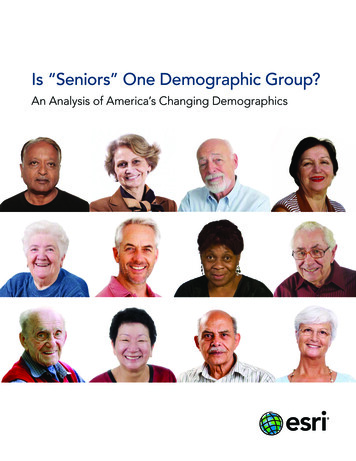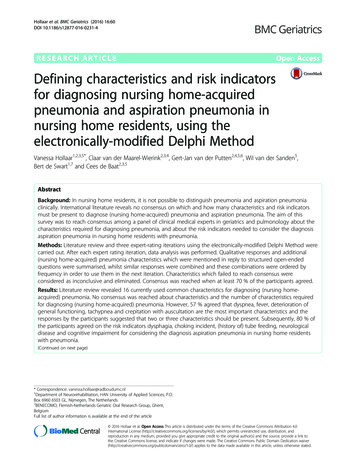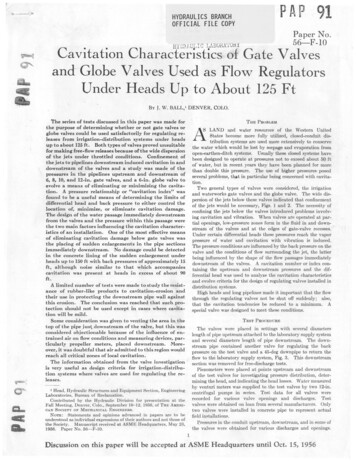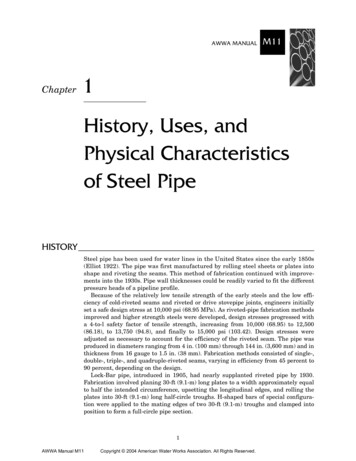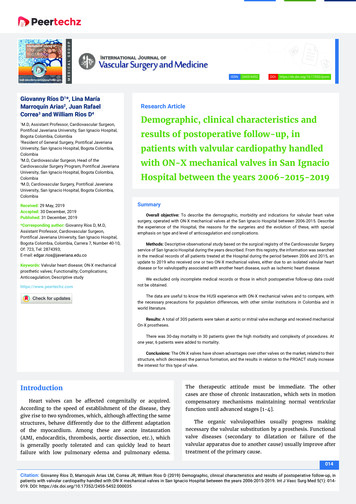
Transcription
MEDICAL GROUPGiovanny Ríos D1*, Lina MaríaMarroquín Arias2, Juan RafaelCorrea3 and William Rios D4M.D, Assistant Professor, Cardiovascular Surgeon,Pontifical Javeriana University, San Ignacio Hospital,Bogota Colombia, Colombia2Resident of General Surgery, Pontifical JaverianaUniversity, San Ignacio Hospital, Bogota Colombia,Colombia3M.D, Cardiovascular Surgeon, Head of theCardiovascular Surgery Program, Pontifical JaverianaUniversity, San Ignacio Hospital, Bogota Colombia,Colombia4M.D, Cardiovascular Surgery, Pontifical JaverianaUniversity, San Ignacio Hospital, Bogota Colombia,Colombia1Received: 29 May, 2019Accepted: 30 December, 2019Published: 31 December, 2019*Corresponding author: Giovanny Ríos D, M.D,Assistant Professor, Cardiovascular Surgeon,Pontifical Javeriana University, San Ignacio Hospital,Bogota Colombia, Colombia, Carrera 7, Number 40-10,Of: 723, Tel: 2874393;E-mail:Keywords: Valvular heart disease; ON-X mechanicalprosthetic valves; Functionality; Complications;Anticoagulation; Descriptive studyhttps://www.peertechz.comISSN:2455-5452DOI: https://dx.doi.org/10.17352/ijvsmResearch ArticleDemographic, clinical characteristics andresults of postoperative follow-up, inpatients with valvular cardiopathy handledwith ON-X mechanical valves in San IgnacioHospital between the years 2006-2015-2019SummaryOverall objective: To describe the demographic, morbidity and indications for valvular heart valvesurgery, operated with ON-X mechanical valves at the San Ignacio Hospital between 2006-2015. Describethe experience of the Hospital, the reasons for the surgeries and the evolution of these, with specialemphasis on type and level of anticoagulation and complications.Methods: Descriptive observational study based on the surgical registry of the Cardiovascular Surgeryservice of San Ignacio Hospital during the years described. From this registry, the information was searchedin the medical records of all patients treated at the Hospital during the period between 2006 and 2015, anupdate to 2019 who received one or two ON-X mechanical valves, either due to an isolated valvular heartdisease or for valvulopathy associated with another heart disease, such as ischemic heart disease.We excluded only incomplete medical records or those in which postoperative follow-up data couldnot be obtained.The data are useful to know the HUSI experience with ON-X mechanical valves and to compare, withthe necessary precautions for population differences, with other similar institutions in Colombia and inworld literature.Results: A total of 305 patients were taken at aortic or mitral valve exchange and received mechanicalOn-X prostheses.There was 30-day mortality in 30 patients given the high morbidity and complexity of procedures. Atone year, 6 patients were added to mortality.Conclusions: The ON-X valves have shown advantages over other valves on the market, related to theirstructure, which decreases the pannus formation, and the results in relation to the PROACT study increasethe interest for this type of valve.IntroductionHeart valves can be affected congenitally or acquired.According to the speed of establishment of the disease, theyThe therapeutic attitude must be immediate. The othercases are those of chronic instauration, which sets in motioncompensatory mechanisms maintaining normal ventricularfunction until advanced stages [1-4].give rise to two syndromes, which, although affecting the samestructures, behave differently due to the different adaptationThe organic valvulopathies usually progress makingof the myocardium. Among these are acute instaurationnecessary the valvular substitution by a prosthesis. Functional(AMI, endocarditis, thrombosis, aortic dissection, etc.), whichvalve diseases (secondary to dilatation or failure of theis generally poorly tolerated and can quickly lead to heartvalvular apparatus due to another cause) usually improve afterfailure with low pulmonary edema and pulmonary edema.treatment of the primary cause.014Citation: Giovanny Ríos D, Marroquín Arias LM, Correa JR, William Rios D (2019) Demographic, clinical characteristics and results of postoperative follow-up, inpatients with valvular cardiopathy handled with ON-X mechanical valves in San Ignacio Hospital between the years 2006-2015-2019. Int J Vasc Surg Med 5(1): 014019. DOI: https://dx.doi.org/10.17352/2455-5452.000035
ournal-of-vascular-surgery-and-medicinea. The stenosis of the exit valves of the ventricles generatesresistance to flow, which is compensated by concentrichypertrophy and good ventricular function is maintaineduntil the myocardium claudicates (hypertrophy createsareas with less coronary risk). As a rule, they themoment when the valvular change will be necessary.b. The insufficiencies lead to ventricular dilation due tovolume overload (eccentric hypertrophy) that initiallycompensates, but degenerates into ventricular failure.The fault is usually before the clinic, making it difficultto predict the existence and require closer control. As aninteresting fact, the higher volume offered increases theejection fraction, so that a seemingly normal value of itcan already indicate slight dysfunction.c. In stenosis of the atrioventricular valves, symptomsoccur due to retrograde congestion (pulmonary inmitral stenosis and systemic in tricuspid stenosis), butthe ventricles are not affected, since they are protectedfrom this pressure increase [1-4].The clinic of the valvulopathies can be both anterogradeand retrograde. In left lesions, pressure is transmitted to thepulmonary vascular bed (with dyspnea, pulmonary edema).This bed responds by increasing the resistance, which initiallyprotects the pulmonary edema, although later it leads toirreversible organic changes in the pulmonary arterioles withpulmonary hypertension and posterior right fault.There may be clinical complications in these valvulardiseases such as embolisms, endocarditis, arrhythmias andeven sudden death.Regarding valve replacements in general, it is accepted thatthromboembolic complications after valve replacement with abiological prosthesis are 0.2-3.8% in the aortic position and0.3-5.1% in the mitral position [1-4].Durability is still an advantage of these valves, since up to90-95% are free of failure at 6-7 years and 70% at 10 years.However, it is necessary to improve these figures.Patients older than 70 years, or with a life expectancy ofless than 10 years and those who can not take anticoagulantsdue to a history of bleeding, or patients who do not want totake anticoagulants are the most appropriate candidates for abiological valve.Regarding mechanical valves, the main complication isthe effects of anticoagulation. It is accepted that morbiditysecondary to hemorrhage is 1-3% per patient per year, andmortality is 0.1-0.5%.For patients between 60 and 70 years, the selection of thetype of prosthesis is usually determined between the patient,the surgeon and the preferences of the center. There is amplecurrent variability, however, in relation to the type of valvethat must be implanted or the option to perform plasty.In our service we have opted for the use of ON-X mechanicalvalves, basically due to the hemodynamic and durabilityadvantages, for the protection of the discs by a wider supportthat prevents obstruction by pannus and by the possibility ofgiving lower doses of warfarin to the patient, and because theyneed potentially lower anticoagulation values.The study by Mervyn A. Williams shows the long-termresults in a population treated with mechanical ON-X valvesand managed with a lower level of anticoagulation in the Rietvan Sonia Provincial Hospital, Port Elizabeth, South Africa.Next, the data taken from this important study are shown [4].The objective of the study was to evaluate the clinicalperformance of the ON-X cardiac valve in a population ofstudents with socioeconomic disadvantages. The majority ofthe patients were indigenous, with low educational level, andwith multiple geographical locations. Between 1999 and 2004,530 valves were implanted (242 mitral valves, 104 aortic valves,92 double valves) in 438 patients (mean age 33 years, range:3-78 years). The most common reason for the surgery wasrheumatic valve disease (57%), followed by degenerative valvedisease (11%) and infectious endocarditis (9%). The followup was 95% for a total of 746 patients-year (pt-year). Amongthe patient population, 40% were without anticoagulation oranticoagulated unsatisfactorily. Hospital mortality was 2.3%and none of the deaths in the hospital was related to the valve.The mean ( SE) survival (including hospital deaths) at fouryears was: 73.8 AVR 8.1%, 83.4 MVR 5.7% and 60.9 10.3DVR%. Linearized rates (by AVR, MVR and DVR, respectively)for late complications (%/pTyr) were: bleeding episodes 0.6,1.0 and 2.3; thrombosis 0.0, 0.2 and 0.0; endocarditis 0.6, 1.0and 2.3; paravalvular leaks 0.6, 0.2, and 0.0; systemic embolism1.1, 1.5 and 3.5. The majority of systemic embolisms are relatedto infective endocarditis. Among the patients there were sevenpregnancies without full-term complications. As a conclusionof the study, taking into account the erratic coverage ofanticoagulation and a high incidence of infective endocarditis,the results of this study can be considered encouraging. Thelow incidence of valve thrombosis (one case) was remarkable.These data also suggest that the On-X valve can be implantedwith relative safety in women who wish to have children. [4].The enthusiasm after the introduction of mechanical valvesduring the 1960s was quickly affected by the documentation ofa high incidence of thromboembolic complications. Althoughthe use of anticoagulants reduced the incidence of thrombosisand thromboembolism, the problem of hemorrhage related tothe anticoagulant was introduced. Consequently, physiciansinvolved in the care of patients with mechanical valves mustfollow a path between bleeding with anticoagulants andthrombotic complications.Among the large number of mechanical valves that havebeen introduced into clinical practice - all of them with thehope that the incidence of valve-related complications will bereduced - few have had long lives and currently only a handfulare implanted in a regular. The ON-X two-disc valve was firstused clinically in September 1996. The valve is manufacturedfrom On-X carbon, a pyrolytic compound without silicone. The015Citation: Giovanny Ríos D, Marroquín Arias LM, Correa JR, William Rios D (2019) Demographic, clinical characteristics and results of postoperative follow-up, inpatients with valvular cardiopathy handled with ON-X mechanical valves in San Ignacio Hospital between the years 2006-2015-2019. Int J Vasc Surg Med 5(1): 014019. DOI: https://dx.doi.org/10.17352/2455-5452.000035
ournal-of-vascular-surgery-and-medicineelimination of silicone from the results of the manufacturing-Describe the postoperative follow-up, with emphasis onprocess has resulted in a much milder surface and theoreticallyfunctional status, values of INR obtained, data accordinglower thrombogenicity. The valve housing has a tubularto the type of valve (aortic or mitral), complications ofconfiguration instead of the configuration of the washer usedanticoagulation and complications with sub-therapeuticin other devices. The valve has a flared inlet and a natural ratiolevels of INR.of length to diameter. This design, when combined with thefull opening prospects, results in linear flow with minimalturbulence. These innovative design features suggest that theOn-X heart valve offers advantages over other mechanicalvalves.Recently the results of the PROACT study have been icValveReplacement Interim results from prospective randomizedON-X Valve anticoagulation Clinical Trial Randomized FDAinvestigational device exemptiom trial “Puskas J. Et al” J.Thorac Cardiovasc Surg 2014, Apr, 147 (4: 12002-12010) doi:10.1016/j.jtcvs 2014.01.004 [5]. 375 AVR patients: 190 controls and 185 cases. September 2006 to 2009. Inr 1.5-2.0 after the 3rd month, plus 89 mg of ASA. INR: 1.89 /- 0.49 Lower bleeding rates. The other complications: TIA and total neurologicalevents were similar.These results of the proact study further support theprogressive use of these valves.Aware of the large population that goes to the CardiovascularSurgery service, and taking into account the greater survival ofthe patients, and the current wide discussion about the type oftechnique and the type of valve selected, it has been decidedto describe the panorama of our patients , to have informationabout the experience, that allows to have an approximatepanorama of the clinical situation with the ON-X valves in auniversity center.Overall objectiveTo describe the demographic and morbidity characteristics,as well as the indications, evolution and complications ofpatients with valvular heart disease to whom one or two ON-Xmechanical valves were implanted in the Hospital San Ignaciobetween the years 2006-2015 an update to 2019.Specific objectives-Describe the sociodemographic variables such as sex,age and origin in the operated patients.--Describe gradients and echocardiographic function inpatients with double mechanical valvular change.MethodsDefinition of the methodIt is a descriptive, observational, historical cohort study,based on a registry. We obtained, by review of medicalrecords, data such as type of valvulopathy, sex, age, surgicalmanagement and technique, associated injuries, type ofcomplications, functional status and prosthesis status, as wellas INR controls and values and the distribution of their valuesaccording to whether there were complications or not.Study populationAll patients with valvular heart disease of all ages, of bothsexes with all types of valvular disease, who had been operatedon with mechanical ON-X valves, in the Cardiovascular SurgeryService of the San Ignacio University Hospital between 20062015 an update to 2019.Inclusion criteriaPatients who underwent surgery at the San Ignacio Hospitalwith a mechanical ON-X prosthesis for the diagnosis of aorticor mitral valve disease, during the period between January2006 and March 2015, whether they had entered through theEmergency Department or scheduled by external consultation.that they had a complete medical history for the necessary data.Exclusion criteriaImpossibility of following the patient by history or bytelephone.Variables: Sex, origin, age, comorbidity, type of valvulopathyand associated diseases, type of surgery performed and locationof ON-X mechanical valves, morbidity and mortality of cardiacvalvular disease operated with mechanical ON-X valves.postoperative functional status, average of INR managed,INR according to valve, complications of anticoagulation,complications according to therapeutic INR or subtherapeuticlevels. Gradients and echocardiographic function in patientswith double mechanical valvular change.Data Collection techniquesSource of information: This is a primary source in aDescribe the indications and comorbidity of the operatedretrospective study based on a registry. The data were obtainedpatients.from the medical records, and additionally the patients werefollowed through postoperative controls and telephone follow--Describe the evolution and morbidity and mortality ofup. The data will be obtained by the researcher through thepatients operated with mechanical ON-X valves.format.016Citation: Giovanny Ríos D, Marroquín Arias LM, Correa JR, William Rios D (2019) Demographic, clinical characteristics and results of postoperative follow-up, inpatients with valvular cardiopathy handled with ON-X mechanical valves in San Ignacio Hospital between the years 2006-2015-2019. Int J Vasc Surg Med 5(1): 014019. DOI: https://dx.doi.org/10.17352/2455-5452.000035
ournal-of-vascular-surgery-and-medicineEvaluation format: Data are obtained retrospectively fromthe Clinical History, with a prospective component of postsurgical follow-up.Collection of the data: the data will be collected betweenMay 2015 and June of the same year. They will be stored ina database in Microsoft Excel and will be processed, forstatistical analysis, in Stata 13 (StataCorp) in the Departmentof Clinical Epidemiology of the Faculty of Medicine, PontificiaUniversidad Javeriana.Control of Biases and Errors: We are aware of the referencebias, because although the population is heterogeneous, theintrinsic characteristics of patients such as race, culturallevel, nutritional status, socioeconomic status, comorbiditiescan not be controlled and are possibly related to the reasonswhy Patients consult or are referred to HUSI. The limitation inextrapolability is assumed, since it is primarily a descriptivestudy in a defined environment. There is no sampling error sincefindings. Sex will be represented in frequency as an absolutevalue.Valvulopathies will be expressed in frequencies, as well asassociated injuries.In the follow-up there may be variability since it is a lessobjective measurement expressed in the feeling of each patientand in some cases with objective measures according to theclinical history and records of echocardiography and INR.The study will make standardized and precoded collectionof registry information, with subsequent validation in patientswho are contacted for echocardiographic evaluation. Potentialerrors in the registry are assumed as weakness of the study,more likely as a random error than as a bias.Results182 patientes 85 women 97 menit is a study in which all the patients operated on with ON-XAverage age 53.8 years.prostheses will be selected for the description of the universe.All the valvulopathies have spectrum variability, given by theDistribución por géneroNumber of patientsPercentagetype of injury, the degree of ventricular involvement, the typeWomen8546.7 %of clinical repercussion and the age of presentation, with theMen9753.2%time of evolution of this. It may happen that the variability isnot well represented by limited sample size, so the descriptivenature of the study is emphasized.There are risks of random error since the data is taken fromOriginNumber of patientsPercentageBogotá14680.21 %Other city3619.7 %the stories, and there may be underreporting. Potentially thiswould mean bias if one thinks that extreme cases are more likelyTYPE OF PROCEDUREnbut it is impossible to quantify this risk, as well as to knowISOLATED AVR70the direction of the error. This is why it is considered moreISOLATED MVR34random error than bias, but it is a clear limitation of the study.AORTIC VALVE REPLACEMENT CABG15MITRAL VALVE REPLACEMENT CABG16AVR ASCENDING AORTA REPLACEMENT12AVR MVR15MVR TRICUSPID ANNULOPLASTY18MVR TVR2to be registered, with very good results or with complications,We will try to validate and complement the information withthe telephone follow-up and in some cases by calling patientswith double valvular change for echocardiography.In the measurement, absolute values recorded in themedical records were used as age-in-years, presence of valvularheart disease, type of injury, valvular change, evolution andcomplications, as well as data related to anticoagulation andrelated complications. We will try to minimize errors in datatrained and will do the process systematically.Analysis plan200180160Preoperative Risk/Comorbidities140For this type of analysis, it is necessary to bear in mind that120most of the measures are expressed in frequency as absolute100values.Patients with On-X valve prostheses2005-201618280According to the evidence, surgical management behaviors60have been taken. The type of mechanical valve does not vary,40but if the position of OENHNNIOYPERT9HUTRITSTS 10%NMALthe average will be obtained within a range according to theTOIn terms of ag
Regarding valve replacements in general, it is accepted that thromboembolic complications after valve replacement with a biological prosthesis are 0.2-3.8% in the aortic position and 0.3-5.1% in the mitral position [1-4]. Durability is still an advantage of these valves, since up to 90-

